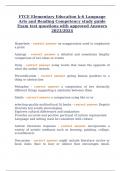FTCE Elementary Education k-6 Language
Arts and Reading Competency study guide
Exam test questions with approved Answers
2023/2024
Hyperbole - correct answer an exaggeration used to emphasize
a point
Analogy - correct answer a detailed and sometimes lengthy
comparison of two ideas or events
Irony - correct answer using words that mean the opposite of
what the author intends
Personification - correct answer giving human qualities to a
thing or abstraction
Metaphor - correct answer a comparison of two distinctly
different things suggesting a similarity between them
Simile - correct answer a comparison using like or as
selecting quality multicultural lit books - correct answer Depicts
diversity but avoids stereotyping
Explores cultural differences and similarities
Provides accurate and positive portrayal of culture represented
Language and setting must be consistent with culture
Artistic literature response - correct answer incorporates a
variety of artistic mediums such as drawing, painting, collage,
scratchboard.
Discussion - correct answer might include literature circles or
book clubs (face to face or online) that encourages small,
,temporary, and heterogeneous groups of students to talk about
the story being read.
Dramatic Response - correct answer poetry readings, readers
theater, storytelling
Inquiry - correct answer includes research about an author or
topic (______ circles)
Written response - correct answer Responding to reading in
writing. Independent graphic organizers, reading logs, learning
logs, and reading response journals
Multimedia tools - correct answer computer software programs
or online resources can enhance reading comprehension. PPT
presentations, wiki pages, digital storytellings, or web-quests in
response to literature.
Developmental Writing Stages - correct answer Scribbling,
mock, handwriting, mock letters, conventional letters, invented
temporary or phonetic spelling and conventional spelling.
The Writing Process - correct answer prewriting, drafting,
revising, editing, publishing
Prewriting - correct answer Activating prior knowledge,
gathering and organizing ideas; may include brainstorming a list
of ideas and researching / reading about a topic; deciding upon
intended audience.
Drafting - correct answer Transfer of ideas to paper; focus on
getting all thoughts down
Revising - correct answer Refining and clarifying the draft;
focus on meaning and further developing the writing piece
, Editing - correct answer Proofreading the draft for misspelled
words, grammar, mechanic errors.
Publishing - correct answer Sharing a final product
Modes of Writing - correct answer narrative writing, persuasive
writing, descriptive writing, expository writing, informative
writing, creative writing
Narrative writing - correct answer writing that recounts a
personal or fictional experience or tells a story based on a real or
imagined event.
Persuasive writing - correct answer writing that attempts to
convince the reader that a point of view is valid or that the
reader should take a specific action
Descriptive writing - correct answer writing that attempts to
"paint a picture" or describe a person, place, thing, or idea
Expository writing - correct answer writing that gives info,
explains why or how, clarifies a process, or defines a concept
Informative writing - correct answer writing that informs the
reader in an attempt to create new found knowledge
Creative writing - correct answer uses the writers imagination
Teaching Writing Conventions - correct answer Include
mechanics such as spelling, punctuation, capitalization, and
grammar. Taught by whole group through modeled, shared and
interactive writing opportunities or to small groups and
individuals during writing conferences. Apply knowledge during
editing and publishing phases of writing process. Rubrics




